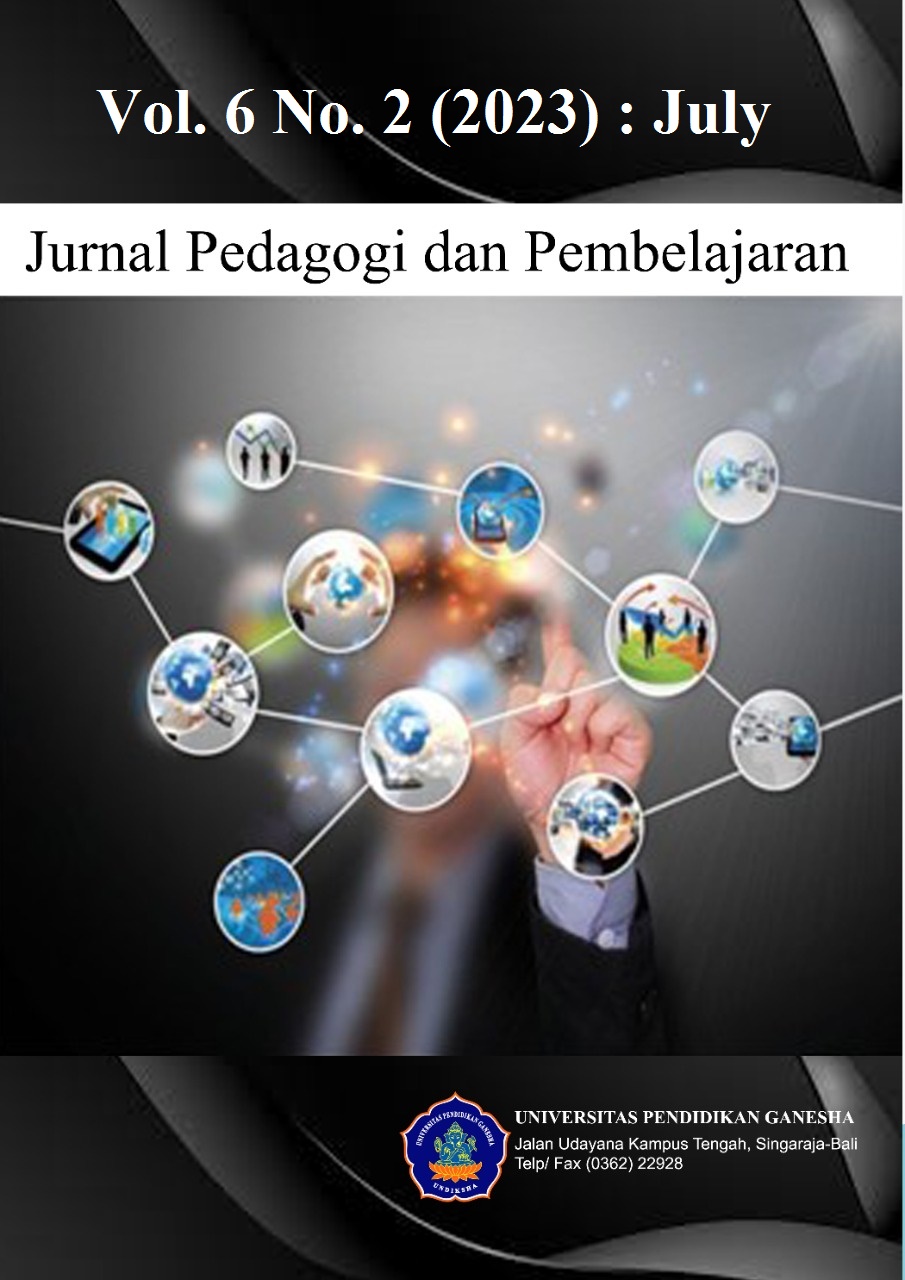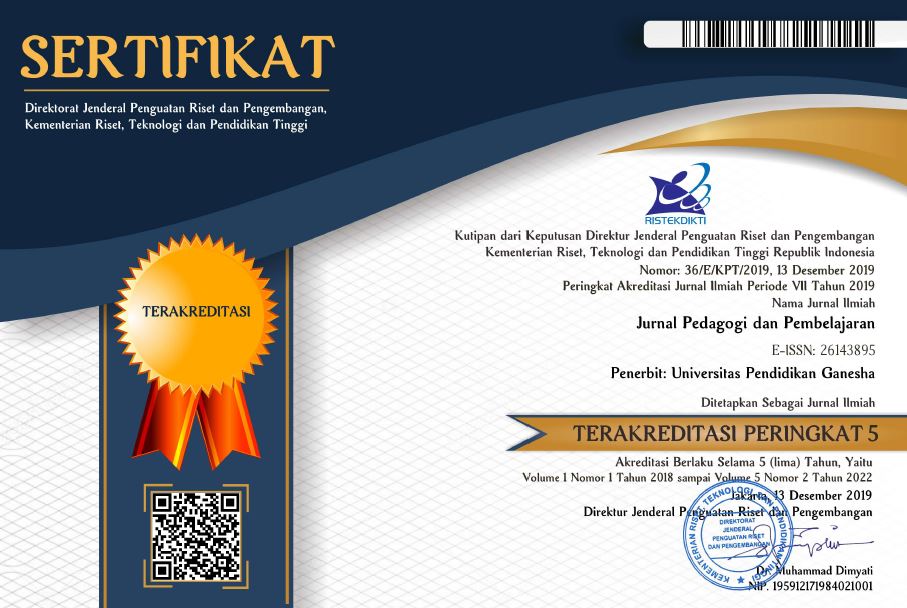Impact of Ambiversion on Collaboration Among Diverse Groups
DOI:
https://doi.org/10.23887/jp2.v6i2.64911Keywords:
Ambiversion, Personality Trait, Diverse Group, Communication EffectivenessAbstract
The coexistence of extroverted and introverted tendencies characterizes the psychological trait known as ambiversion. The impact of ambiversion on collaboration among various groups has received limited attention in the literature. This study examines the relationship between ambiversion and collaboration among individuals with culturally diverse backgrounds, using three leading theoretical models in personality psychology: the HEXACO Model, the Big Five Model, and the Myers-Briggs Type Indicator Model (MBTI). This type of research is qualitative research (literary study). The data collected and analyzed are secondary data from research results such as relevant books, journals, articles, internet sites, and others. Data analysis techniques in this study used content analysis data analysis techniques. The results of the study, namely, in particular the HEXACO Model, highlight the importance of openness to experience in facilitating collaboration among various groups. In contrast, the Big Five Model emphasizes the role of conscientiousness in this relationship. The MBTI model must provide significant evidence of its contribution to the relationship between ambiversion and collaboration between diverse groups. It concluded that individuals and organizations could create ways to encourage successful collaboration and teamwork while leveraging the capabilities of various team members by identifying the strengths and specific problems of ambiverts.
References
Ashton, M. C., Lee, K., & Vries, R. E. (2014). The HEXACO honesty-humility, agreeableness, and emotionality factors: A review of research and theory. Personality and Social Psychology Review, 18(2), 139–152. https://doi.org/10.1177/1088868314523838. DOI: https://doi.org/10.1177/1088868314523838
Bandura, A., & McClelland, D. (1977). Social learning theory (1st ed). Prentice Hall: Englewood cliffs.
Barrick, M. R., & Mount, M. K. (1991). The Big Five personality dimensions and job performance: A meta-analysis. Personnel Psychology, 44(1), 1–26. https://doi.org/10.1111/j.1744-6570.1991.tb00688.x. DOI: https://doi.org/10.1111/j.1744-6570.1991.tb00688.x
Bischoff, K., Volkmann, C. K., & Audretsch, D. B. (2018). Stakeholder collaboration in entrepreneurship education: an analysis of the entrepreneurial ecosystems of European higher educational institutions. The Journal of Technology Transfer, 43(1), 20–46. https://doi.org/10.1007/s10961-017-9581-0. DOI: https://doi.org/10.1007/s10961-017-9581-0
Cain, S. (2012). Quiet: The Power of Introverts in a World That Can’t Stop Talking. Crown Publishing Group. DOI: https://doi.org/10.1037/e549532012-001
Castaner, X, & Oliveira, N. (2020). Collaboration, Coordination, and Cooperation Among Organizations: Establishing the Distinctive Meanings of These Terms Through a Systematic Literature Review. Journal of Management, 46(6), 965–1001. https://doi.org/10.1177/0149206320901565.
Castaner, Xavier, & Oliveira, N. (2020). Collaboration, Coordination, and Cooperation Among Organizations: Establishing the Distinctive Meanings of These Terms Through a Systematic Literature Review. Journal of Management, 46(6), 965–1001. https://doi.org/10.1177/0149206320901565/ASSET/IMAGES/LARGE/10.1177. DOI: https://doi.org/10.1177/0149206320901565
Çelik, A. K., Yıldız, T., Aykanat, Z., & Kazemzadeh, S. (2021). The impact of narrow personality traits on entrepreneurial intention in developing countries: A comparison of Turkish and Iranian undergraduate students using ordered discrete choice models. European Research on Management and Business Economics, 27(1). https://doi.org/10.1016/j.iedeen.2020.100138. DOI: https://doi.org/10.1016/j.iedeen.2020.100138
Costa, P. T., & McCrae, R. R. (1992). Revised NEO Personality Inventory (NEO-PI-R) and NEO Five-Factor Inventory (NEO-FFI) professional manual. Psychological Assessment Resources.
Grant, A. (2013). The surprising benefits of being an ambivert. Harvard Business Review.
Grant, A. M. (2013). Rethinking the extraverted sales ideal: The ambivert advantage. Psychological Science, 24(6), 1024–1030. https://doi.org/10.1177/0956797612463706. DOI: https://doi.org/10.1177/0956797612463706
Grant, A. M., & Berry, J. W. (2011). The necessity of others is the mother of invention: Intrinsic and prosocial motivations, perspective-taking and creativity. Academy of Management Journal, 54(1), 73–96. https://doi.org/10.5465/AMJ.2011.59215085. DOI: https://doi.org/10.5465/amj.2011.59215085
Grant, A. M., Gino, F., & Hofmann, D. A. (2011). Reversing the extraverted leadership advantage: The role of employee proactivity. Academy of Management Journal, 54(3), 528–550. https://doi.org/10.5465/amj.2011.61968043. DOI: https://doi.org/10.5465/amj.2011.61968043
Grant, A. M., & Schwartz, B. (2011). Too much of a good thing: The challenge and opportunity of the inverted U. Perspectives on Psychological Science, 6(1), 61–76. https://doi.org/10.1177/1745691610393523. DOI: https://doi.org/10.1177/1745691610393523
Kim, K. H., Oh, H., & Kim, Y. J. (2021). The role of ambiversion in cross-cultural collaboration: A dyadic perspective. Journal of Business Research, 131, 168–177.
Liu, S., Keeley, J. W., Sui, Y., & Sang, L. (2021). Impact of distributed leadership on teacher job satisfaction in China: The mediating roles of teacher autonomy and teacher collaboration. Studies in Educational Evaluation, 71. https://doi.org/10.1016/j.stueduc.2021.101099. DOI: https://doi.org/10.1016/j.stueduc.2021.101099
Liu, Y., Bellibaş, M. Ş., & Gümüş, S. (2020). The effect of instructional leadership and distributed leadership on teacher self-efficacy and job satisfaction: Mediating roles of supportive school culture and teacher collaboration. Educational Management Administration and Leadership, 1–24. https://doi.org/10.1177/1741143220910438. DOI: https://doi.org/10.1177/1741143220910438
Menges, J., & Kilduff, M. (2015). Group Personality Composition and Group Outcomes: The Importance of Personality Dissimilarity. Journal of Personality and Social Psychology, 109(6), 1068–1084. https://doi.org/10.1177/1046496404268538. DOI: https://doi.org/10.1177/1046496404268538
Nordgren, K., Kristiansson, M., Liljekvist, Y., & Bergh, D. (2021). Collegial collaboration when planning and preparing lessons: A large-scale study exploring the conditions and infrastructure for teachers’ professional development. Teaching and Teacher Education, 108. https://doi.org/10.1016/j.tate.2021.103513. DOI: https://doi.org/10.1016/j.tate.2021.103513
Prasetyo, R. I., Hidayat, N., & Dimas, A. (2019). Studi Literature Model Pembelajaran POE (Predict, Observe, and Explain). penguatan pendidikan dan kebudayaan, 704–710.
Salmony, F. U., & Kanbach, D. K. (2021). Personality trait differences across types of entrepreneurs: a systematic literature review. In Review of Managerial Science (Number 0123456789). Springer Berlin Heidelberg. https://doi.org/10.1007/s11846-021-00466-9. DOI: https://doi.org/10.1007/s11846-021-00466-9
Sauli, F. (2021). The collaboration between Swiss initial vocational education and training partners: perceptions of apprentices, teachers, and in-company trainers. Empirical Research in Vocational Education and Training, 13(1), 1–14. https://doi.org/10.1186/s40461-021-00114-2. DOI: https://doi.org/10.1186/s40461-021-00114-2
Srivastava, S., Tamir, M., McGonigal, K., John, O. P., & Gross, J. J. (2008). The social costs of emotional suppression: A prospective study of the transition to college. Journal of Personality and Social Psychology, 94(2), 245–263. https://doi.org/https://doi.org/10.1037%2Fa0014755.
Tanaka, Y., Nishi, Y., Nishi, Y., Osumi, M., & Morioka, S. (2017). Uncovering the influence of social skills and psychosociological factors on pain sensitivity using structural equation modeling. Journal of Pain Research, 10(7), 2223–2231. https://doi.org/10.2147/JPR.S143342. DOI: https://doi.org/10.2147/JPR.S143342
Wu, Cw., Chen, & Chen, Y. C. (2021). Ambiversion and team performance: The mediating roles of task-oriented and relationship-oriented behaviours. Journal of Business Research, 130, 15–25. https://doi.org/10.2224/sbp.2009.37.10.1391. DOI: https://doi.org/10.2224/sbp.2009.37.10.1391
Downloads
Published
How to Cite
Issue
Section
License
Copyright (c) 2023 Moses Adeleke Adeoye, Kamoru Abidoye Tiamiyu, Musa Aremu Mahmud, Hassanat Abdullateef Jimoh

This work is licensed under a Creative Commons Attribution-ShareAlike 4.0 International License.
Authors who publish with Jurnal Pedagogi dan Pembelajaran agree to the following terms:- Authors retain copyright and grant the journal the right of first publication with the work simultaneously licensed under a Creative Commons Attribution License (CC BY-SA 4.0) that allows others to share the work with an acknowledgment of the work's authorship and initial publication in this journal
- Authors are able to enter into separate, additional contractual arrangements for the non-exclusive distribution of the journal's published version of the work (e.g., post it to an institutional repository or publish it in a book), with an acknowledgment of its initial publication in this journal.
- Authors are permitted and encouraged to post their work online (e.g., in institutional repositories or on their website) prior to and during the submission process, as it can lead to productive exchanges, as well as earlier and greater citation of published work. (See The Effect of Open Access)













